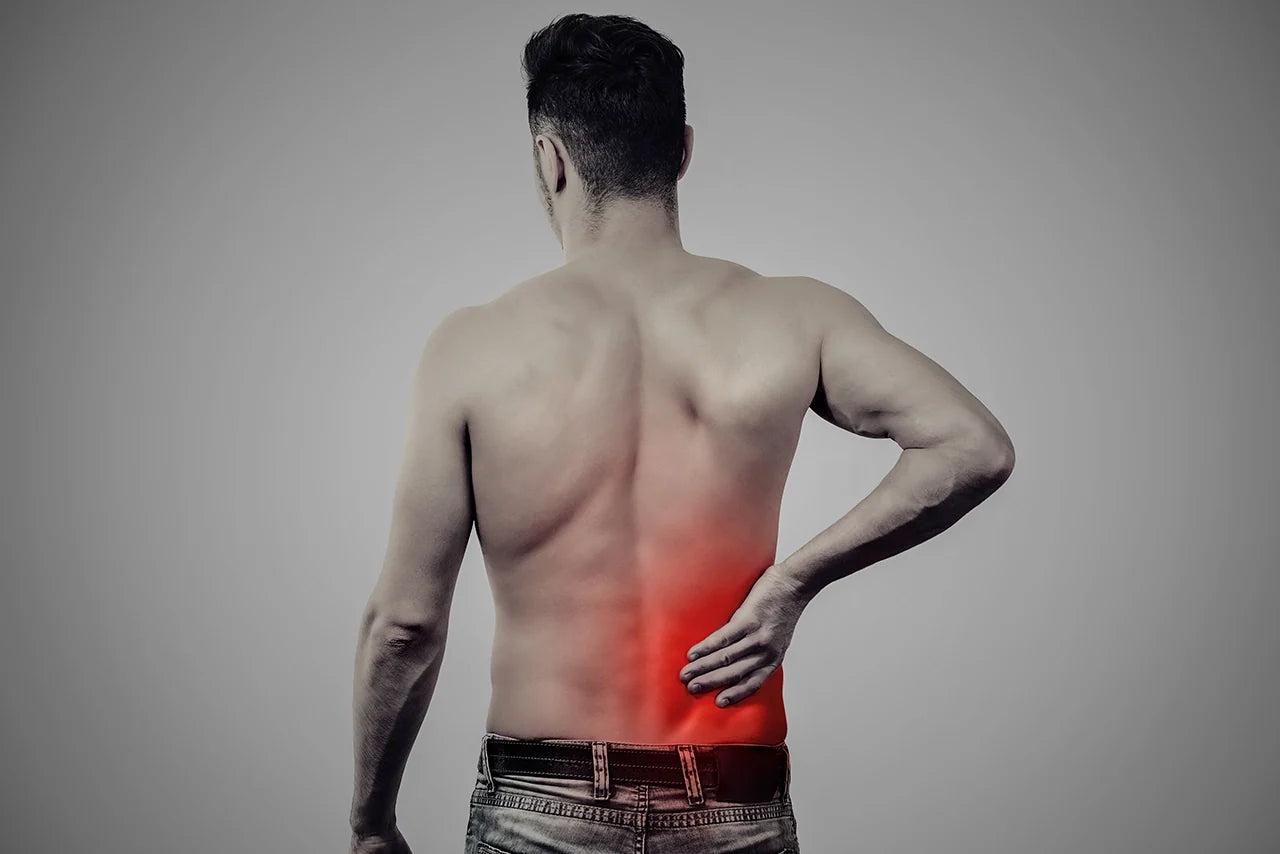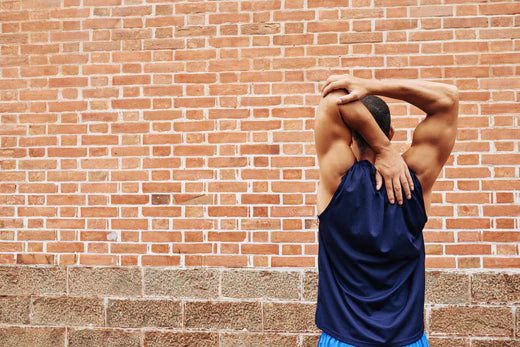Une ceinture d’haltérophilie peut-elle réduire le risque de blessure au bas du dos ?

Le rôle de la ceinture d'haltérophilie
Une ceinture de levage est fixée autour de la taille et du dos, au-dessus du nombril. Elle est généralement censée soutenir et protéger le bas du dos des blessures telles que les douleurs dorsales et les hernies discales.
Comment cela fonctionne-t-il ? Il augmente la pression intra-abdominale, ce qui contribue à solliciter les muscles de stabilité du tronc entourant la partie médiane et assure la neutralité vertébrale.
En termes simples, il peut maintenir la colonne vertébrale droite et l'empêcher de se courber vers l'avant, de se charger et de se blesser.
Cependant, nous devons comprendre que les ceintures de levage ne se limitent pas à réduire le risque de blessures au bas du dos.
La question qu’on nous pose souvent est : « mais une ceinture peut-elle vous aider dans vos exercices ? »
Absolument ! Maintenir le dos stable permet de maintenir l'énergie de levage sur les muscles sollicités, au lieu de la perdre lors des mouvements vertébraux.
Cela améliore les performances de levage à court terme, ce qui peut influencer la force et les gains musculaires à long terme.
Sur la base de la notion de ceinture d'haltérophilie et du risque réduit de blessure au bas du dos, nous avons couvert :
- Les 6 principaux muscles du tronc
- Deux façons dont les ceintures de levage aident votre dos
- Blessures lombaires courantes et coûteuses
- Ceintures d'haltérophilie pour les poids plus lourds ?
- Ceinture d'haltérophilie en cuir véritable que nous recommandons
Les 6 principaux muscles du tronc
Il est important de comprendre les muscles de stabilité du tronc avant de plonger dans l’impact de la ceinture de dynamophilie pour la sécurité du bas du dos.
Grand droit de l'abdomen (muscles abdominaux)
Les abdominaux au niveau de la partie médiane ou comme nous les connaissons le muscle « six pack » sont connus sous le nom de grand droit de l'abdomen.
Le mouvement principal du grand droit de l'abdomen consiste à plier le tronc et à aider à stabiliser la colonne vertébrale.
Muscles érecteurs du rachis
Les muscles érecteurs du rachis sont composés de huit muscles et d'un tendon commun qui part du bas du dos et se prolonge jusqu'au haut du dos. Ce groupe musculaire contribue à la stabilisation de la colonne vertébrale et à la flexion vers l'arrière.
Muscle transverse de l'abdomen
Un autre muscle qui aide à stabiliser la colonne vertébrale est situé profondément derrière le droit fémoral.
Obliques
Il existe deux types d'obliques : les obliques internes et les obliques externes. Ces muscles de la stabilité centrale parcourent le tronc et empêchent la colonne vertébrale de se tordre lors du soulèvement.
Muscles du plancher pelvien
Les muscles du plancher pelvien se situent dans le bassin, sous la colonne vertébrale. Ils contribuent à stabiliser la partie inférieure de la colonne vertébrale.
Multifidus
Le multifidus est le muscle le plus grand et le plus fort qui assure la stabilité de la colonne vertébrale et il est le plus épais vers le bas du dos,
Deux façons dont les ceintures de levage aident votre dos
La ceinture de levage peut soulager votre dos de deux manières principales : d'une part, elle réduit les risques de blessures et, d'autre part, elle améliore vos performances.
Aide à engager le tronc et réduit le risque de blessure au dos
Comme indiqué précédemment, six principaux muscles de stabilité du tronc entourent la partie médiane du corps et maintiennent le dos dans une position neutre pendant le levage.
Si les muscles de stabilité du tronc ne sont pas suffisamment forts, par exemple lors d’un squat avec haltères lourds, le dos pourrait se courber vers l’avant avec un risque élevé de blessure musculaire ou vertébrale.
Courbure/ chargement du dos c'est une position non naturelle, et particulièrement dangereuse lorsque l'on soulève des poids lourds.
Pour cette raison, la ceinture de levage est considérée comme un excellent accessoire qui aide à augmenter la pression intra-abdominale et à engager les muscles de stabilité du tronc à un degré plus élevé.
La ceinture est certainement recommandée lors de l'observation de poids lourds supérieurs à 90 %, comme nous l'avons vu plus loin dans l'article.
Des levées et une activité musculaire plus efficaces grâce au maintien de l'énergie de levage
Lorsqu’un individu n’est pas assez fort pour effectuer un exercice comme le squat ou le soulevé de terre à une intensité donnée, nous avons tendance à voir le dos céder et se courber ou se projeter vers l’avant.
Non seulement cela présente un risque de blessure, mais cela libère également une grande partie de l'énergie de l'ascenseur et soulage les muscles qui travaillent et réduit les performances de levage à court terme.
Comme mentionné, la ceinture de levage peut aider à stabiliser le dos, empêchant ainsi la perte d'énergie de levage.
En fait, un Une étude publiée dans le Journal of Strength and Conditioning Research a révélé qu'en appliquant simplement une ceinture de levage, les haltérophiles expérimentés étaient capables d'améliorer leurs performances en squat avec haltères de 3 à 5 %.
Ainsi, par exemple, si vous pouvez faire des squats avec une barre de 300 livres, une ceinture de levage peut vous permettre de soulever jusqu'à 15 livres supplémentaires !
De meilleures performances de levage à court terme peuvent se traduire par des gains musculaires et de force à long terme.
Blessures lombaires courantes et coûteuses
Le muscle érecteur du rachis est le muscle qui débute dans le bas du dos. Comme nous l'avons souligné, un manque de force intra-abdominale peut entraîner une courbure du dos lors d'exercices comme le squat à la barre et le soulevé de terre.
Les blessures lombaires courantes et coûteuses comprennent les élongations des muscles érecteurs du rachis (muscles lombaires) et les hernies discales (rachidiennes). Nous les détaillons ci-dessous.
Entorse ou déchirure musculaire du bas du dos
Il existe trois degrés de déchirure musculaire du bas du dos : le grade 1 correspond à une entorse, le grade 2 à une déchirure partielle et le grade 3 à une rupture complète des muscles, nécessitant une intervention chirurgicale pour restaurer la fonction.
Hernie discale
Une hernie discale survient lorsqu'un disque dorsal est forcé à travers une partie fragile de la colonne vertébrale. Ce phénomène se produit généralement lors d'un entraînement musculaire intensif et de sollicitations excessives de la colonne vertébrale. Selon la gravité de la blessure, un recours à la médecine contemporaine ou à la chirurgie peut être nécessaire.
Ceintures d'haltérophilie pour les poids plus lourds ?
Les ceintures d'haltérophilie sont généralement utilisées pour soulever des charges lourdes à haute intensité. Pourquoi ? Soulever des charges plus lourdes sollicite davantage la force abdominale, et ceux qui n'en possèdent pas peuvent avoir du mal à contrôler les mouvements de leur colonne vertébrale.
Nous avons présenté un exemple d'intensité de squat pouvant nécessiter une ceinture d'haltérophilie. Notez que ces exemples sont des recommandations générales et non individualisées.
- 1 x 308 lb = à 100 % d'intensité
- 2 x 292 lb = à 95 % d'intensité
- 3 x 286 lb = à 93 % d'intensité
- 4 x 275 lb = à 90 % d'intensité
- 5 x 270 lb = @87 % d'intensité
- 6 x 264 lb = @85 % d'intensité
- 7 x 253 lb = @83 % d'intensité
- 8 x 242 lb = @80 % d'intensité
- 9 x 236 lb = @77 % d'intensité
- 10 x 231 lb = @75 % d'intensité
Ceinture d'haltérophilie en cuir véritable que nous recommandons
Maintenant que vous avez suscité un vif intérêt pour la ceinture d'haltérophilie, nous avons couvert une ceinture d'haltérophilie en cuir véritable de haute qualité que nous recommandons.
La ceinture à double pointe Iron Bull PRO 10 mm 4" est une option incroyable qui peut vous accompagner dans tous vos entraînements brutaux d'haltérophilie, de dynamophilie et de musculation.
Il est disponible dans les tailles de taille suivantes :
- S : 25-30”
- M : 30-35”
- L : 35-40”
- XL : 40-45”
- XXL : 45-50”
- XXXL : 50”+
La ceinture d'haltérophilie Iron Bull Strength coûte 110 $, ce qui est raisonnable compte tenu de la qualité de niveau A, de l'authenticité et de la transparence.
Iron Bull Strength propose une livraison nationale gratuite aux États-Unis pour les commandes supérieures à 150 $, une option « acheter maintenant et payer plus tard » (versements) et une garantie de remboursement de 30 jours.
Ce qui augmente vraiment la transparence de la ceinture à double broche, c'est qu'elle est certifiée par les compétitions de dynamophilie IPF, USPA, USAPL et IPL, c'est pourquoi nous la considérons comme la meilleure ceinture d'haltérophilie.
SPÉCIFICATION TYPE : conception droite MATÉRIAU : Ceinture en cuir véritable FINITION : Daim ÉPAISSEUR : 10 mm (Tolérance +/- 1 mm) LARGEUR : 10 cm (3,9 pouces) FERMETURE : Boucle à rouleau à double ardillon en acier CERTIFICATION : IPF/USAPL/USPA/IPL
Foire aux questions (FAQ)
Q : « Où devez-vous positionner votre ceinture d’haltérophilie ? » A : Sous la cage thoracique, au-dessus de l'os de la hanche, autour de la taille et du nombril
Q : « Le port d’une ceinture dorsale pourrait-il augmenter le risque de blessure ? » R : Si la ceinture est trop serrée, elle restreint la respiration ou les mouvements pendant le levage, ce qui peut alors provoquer une chute et une blessure par objet contondant.
Q : « Faut-il porter une ceinture d’haltérophilie lorsque l’on soulève des poids ? » R : Les ceintures de musculation sont généralement utilisées pour les exercices debout avec poids libres, comme le squat à la barre, le soulevé de terre et le développé couché. Nous vous conseillons de les utiliser pour soulever des charges lourdes à plus de 75 % d'intensité, ce qui nécessite une pression intra-abdominale plus importante.
Q : « Quels exercices sont les meilleurs pour les ceintures d’haltérophilie ? » A : Barre Squats, soulevés de terre, tirages arrière avec haltères, développé couché
Conclusion
Globalement, la ceinture d'haltérophilie contribue à augmenter la pression intra-abdominale et à solliciter la ceinture abdominale. Cela permet de maintenir la neutralité vertébrale pendant les exercices et de réduire les risques de courbure/charge vertébrale et de blessures lombaires telles qu'une élongation.
De plus, la ceinture de levage peut améliorer vos performances en prévenant la perte d'énergie liée aux mouvements de la colonne vertébrale. Elle est généralement utilisée lors du levage de charges dont l'intensité dépasse 75 %.
La ceinture d'haltérophilie que nous recommandons est la ceinture Iron Bull Strength PRO 10MM 4" DOUBLE PRONG BELT pour sa qualité, son authenticité et sa transparence.
Merci de votre lecture ! N'hésitez pas à laisser un commentaire, une question ou une demande ; nous vous répondrons dans les plus brefs délais.
Section de référence
- Lavender, SA, Shakeel, K., Anderson, GB, et al. Effets d'une ceinture de levage sur les moments rachidiens et le recrutement musculaire après une charge soudaine et inattendue. Spine 25(12) : 1569-1578, 2000.
- Oliva-Lovano, JM, &., Muyer, JM Activité musculaire centrale pendant les exercices de conditionnement physique : une revue systématique Revue internationale de recherche environnementale et de santé publique 17(12):4306, 2020
- Zink, AJ, Whiting, WC, Vincent, WJ, et al. Effets d'une ceinture lestée sur l'activité musculaire du tronc et des jambes et la cinématique articulaire pendant l'exercice de squat . Journal of Strength and Conditioning Research 15(2) : 235-240, 2001

